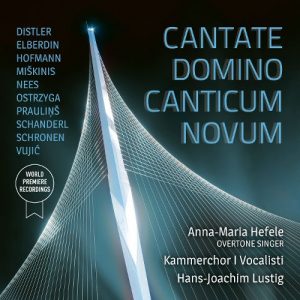Critic’s Picks… Cantate Domino Canticum Novum, Kammerchor I Vocalisti
By T. J. Harper, D. M. A., choral conductor and teacher
Cantate Domino Canticum Novum
Kammerchor I Vocalisti
Featuring Anna-Maria Hefele, Overtone Singer
Hans-Joachim Lustig, Conductor
Church of the Stephansstift Hannover
(2016; 73’ 09”)
It is a rare occurrence when a new choral recording manages to celebrate a common theme where every performance is characterised by both vigor and substance. This is especially rare when the common theme in question revolves around a singular textual concept. In Cantate Domino Canticum Novum, conductor Hans-Joachim Lustig has managed to achieve this to great effect in his Kammerchor I Vocalisti featuring overtone singer, Anna-Maria Hefele. Recorded between March and July 2016 at the Church of the Stephansstift Hannover, this latest offering from Hans-Joachim Lustig is an eclectic mix of 20th and 21st century compositions that utilize the same text from three different language traditions: “Sing to the Lord a new song”, “Cantate Domino canticum novum”, and “Singet dem Herrn ein neues Lied”.
Anchored in recent history, the common theme of this CD, Cantate Domino Canticum Novum, takes much of its aesthetic and spiritual energy from Hugo Distler’s setting of Singet dem Herrn ein neues Lied composed in 1934. Influenced by the compositional techniques of Heinrich Schütz and Johann Sebastian Bach, Lustig allows Distler’s setting to firmly place the long tradition of church music at the center of this recording.
Adding to the heart of this collection of “new songs” is the unique and powerful voice of overtone singer and vocal artist, Anna-Maria Hefele. Having completed advanced studies at the Carl Orff Institute at the Mozarteum Salzburg and the Deutches Museum München, Hefele specialises in overtone singing, a vocal technique which involves filtering and amplifying the natural harmonics in one’s voice so that it sounds as if that person is singing two notes at the same time. In the compositions of Uģis Prauliņš (1957), Hans Schanderl (1960), and Michael Ostrzyga (1975), Anna-Maria Hefele provides a novel sound layer to each of the three compositions in which she is featured, that at once, become intoxicating, musical and remarkably sensitive.
Kammerchor I Vocalisti is made up of singers from around northern Germany and was founded in 1991. They have performed on the international stage and won first prize at the 6th Deutcher Chorwettbewerb in 2002, the International Chamber Choir Competition in Tolosa, Spain in 2004, and the International Choir Competition in Cork, Ireland in 2009. Their conductor, Hans-Joachim Lustig is a freelance choral director who directs the Chorknaben Uetersen and leads choral conducting seminars throughout Europe.
- *Cantate Domino by Uģis Prauliņš (b. 1957) was composed in 2015 and is a motet on Psalm 98 for 8-voice choir and overtone singing for solo voice. In this work, Prauliņš creates an exceptional fusion of modern classical choral vocalisation with overtone expression.
- Singet dem Herrn by Vic Nees (1933-2013). Written in 2002 for 4-6 voice choir and soprano solo. This setting of Psalm 98 brings a refreshing look at the bright and exclamatory praise offered in the text.
- …Singet… by Thomas Hofmann (1958). Composed in 2000, this motet for two 4-voice choirs is a fitting prelude to Singet dem Herrn by Distler, a setting which allows the text declamation to be the primary inspiration. Hofmann states, “In choosing my compositional resources and with all appropriate allegorical means – in the form of an apotheosis, required clarification in the form music with an open conclusion.”
- Singet dem Herr ein neues Lied op. 12 no. 1 by Hugo Distler (1908-1942) stands as the historical centerpiece of this recording and is handled with great sophistication and clarity. Composed in 1934, the musical language of this work is strongly influenced by the text and has a connection to Heinrich Schütz. “In this way we make clear that the Psalm text of the title has a long tradition in church music” – Hans-Joachim Lustig.

Hans-Joachim Lustig - Cantate Domino by Josu Elberdin (1976) is a Motet combining the texts from Psalm 96 and 98 for 8-voice choir. Composed in 2011, this work is characterised by parallel 4th, 5ths and octaves where men’s and women’s voices work independently for interplay before unity. This work is also unique in that the text is set partly in Euskarian, the language of the Basque composer’s home country.
- Cantate Domino by Hans Schanderl (1960) for 8-voice choir and overtone singing for solo voice was composed in 2016. Portions of Psalm 96 are used in repetition combined with phonetic syllables and calls for masterful overtone improvisation. “For me, the basic tone of this composition was the thought of an expression of joy, in the sense of a hymn-like jubilation that develops in a dance-like style within the musical texture.” – Hans Schanderl
- Singet dem Herr ein neues Lied by Aleksandar S. Vujić (1945) based on the text of Psalm 149 this work for 16 voices is an homage to J. S. Bach. Serbian composer Vujić states, “My idea was to follow Bach’s lead but with something new added to it, something that would give it a new impetus. In doing so, I restricted myself to using one dimension. I chose irregular rhythms, as are typical for the Balkans, and yet maintained and applied the principals of Bach’s double choir choral works: polyphony, homophony and imitation. I did not want to find any extremely modern sounds and therefore consciously set boundaries for myself.”
- Cantate Domino by Vytautas Miškinis (1954) exudes an artistic radiance that corresponds to the text and subtext. This work is appealing for its warm and harmonious style.
- Canticum Novum (…ab extremis terrae) by Michael Ostrzyga (1975) was composed between 2015 and 2016 for Kammarchor I Vocalisti and an overtone soloist. “The composition moves between different dimensions: music without text, recitations without music, semantic and phonetic, deconstruction and reconstruction, clarity and blurriness, noise and note, undertones and overtones, concrete and transfigured, becoming and vanishing”, a work of extremes. “The words ‘ab extremis terrae’ (from the ends of the earth; Isaiah 42:10) remained in my mind from the very beginning in a different sense of the meaning, even though this is most likely not what is meant in the context of the Bible passage: as a junction between the material terrestrial world and the immaterial extraterrestrial world. For this reason, I decided to use only the beginning of the text and to liberate it from the concrete context.” – Michael Ostrzyga
- Cantate Domino by Alwin Michael Schronen (1965) Composed in 2015, this work unmistakably refers to the harmonies and characteristic style of the Baltic countries’ contemporary vocal music. “The text expresses great joy. I translated this into the composition by means of a triple time measure and a double choir arrangement between a three-part women’s choir and a three part men’s choir”. The structure of overlapping homophonic textures of the male and female voices is unique.
Edited by Rebeka Angstamann, UK

